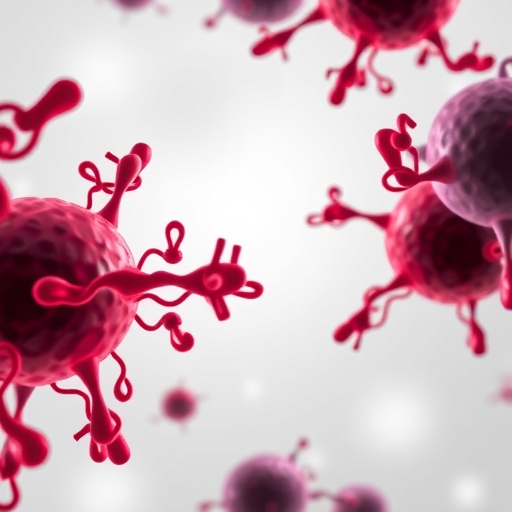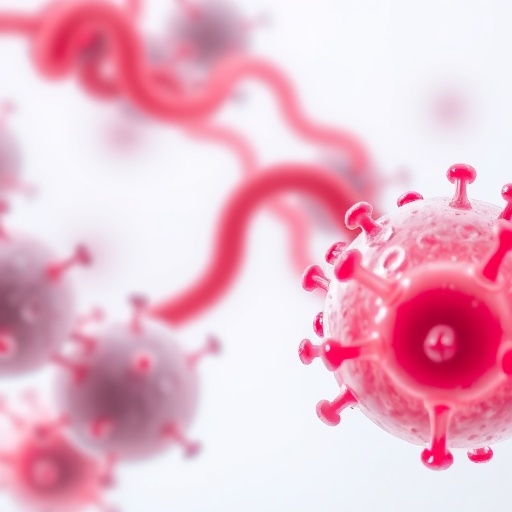In the relentless pursuit of next-generation cancer therapies, a groundbreaking discovery has emerged from the laboratories of Wilson, Zhu, Vinciauskaite, and their colleagues, now published in Nature Communications. Their study unveils a remarkable synergy between WEE1 inhibitors and defects in mRNA translation, mediated through the activation of the integrated stress response kinase GCN2, illuminating new therapeutic avenues for combating treatment-resistant malignancies.
The complexity of cancer biology often demands multifaceted therapeutic strategies, particularly given tumors’ notorious ability to bypass single-agent treatments. WEE1, a pivotal cell cycle regulator kinase, has long been recognized as a critical modulator of the G2/M checkpoint, preventing premature entry into mitosis upon DNA damage. Inhibition of WEE1 has surfaced as a promising anticancer strategy by exacerbating replication stress, driving cancer cells to catastrophic mitotic entry. Yet, the therapeutic efficacy of WEE1 inhibitors has been variably limited across cancer types, prompting a deeper exploration of their cellular context and interactions.
The current research propels this investigation into new territory by exploring how defects in mRNA translation amplify the efficacy of WEE1 inhibition. mRNA translation, the process by which ribosomes decode messenger RNA to synthesize proteins, is fundamental to cellular homeostasis and stress adaptation. Aberrations in translational control, a frequent hallmark in cancer, can induce proteotoxic stress and activate adaptive signaling pathways. The study identifies such translational defects as critical in modulating cellular responses to WEE1 inhibitors.
Central to this interplay is the kinase General Control Nonderepressible 2 (GCN2), a well-characterized sensor of amino acid deprivation and ribosomal stalling. GCN2 activation triggers the phosphorylation of eukaryotic initiation factor 2 alpha (eIF2α), initiating the integrated stress response (ISR) that attenuates global protein synthesis while selectively promoting stress-responsive gene expression. The research delineates how translation perturbations induced by certain genetic or pharmacological means potentiate WEE1 inhibitor action through the robust activation of GCN2 signaling pathways.
Utilizing a combination of cutting-edge genetic screens, transcriptomic profiling, and pharmacological assays, the authors elegantly demonstrate that cells harboring translation defects exhibit heightened sensitivity to WEE1 inhibition. This synthetic lethality hinges on an exacerbated cellular stress landscape that overwhelms cancer cells’ protective mechanisms. Intriguingly, the study reports that GCN2 activation is not merely a bystander effect but plays a causative role in mediating this synergy, positioning it as a potential biomarker for therapeutic responsiveness.
Delving into mechanistic nuances, the authors show that GCN2 activation upon combined WEE1 inhibition and translation stress leads to profound disruptions in proteostasis and DNA damage repair pathways. This culminates in the accumulation of unrepaired DNA lesions, mitochondrial dysfunction, and ultimately, apoptotic cell death. The cooperative engagement of these stress response axes offers a compelling explanation for the enhanced cytotoxicity observed, suggesting that co-targeting these pathways could circumvent resistance mechanisms inherent to monotherapy approaches.
From a translational standpoint, these findings carry significant implications for precision oncology. The identification of translation defects—or even pharmacologically induced translation stress—as sensitizing factors to WEE1 inhibitors opens the door for rational combinatorial regimens. This could include agents that modulate the translational machinery or stress response kinases, refining patient selection and optimizing therapeutic windows.
Furthermore, this work raises important questions about the broader landscape of cancer vulnerabilities tied to translational control and stress responses. Since many tumors exhibit intrinsic or therapeutically induced dysregulation in protein synthesis, understanding how these pathways intersect with cell cycle checkpoints and DNA damage responses could unveil universal targets across cancer types. The GCN2 axis, in particular, emerges as an intriguing node warranting further investigation both as a therapeutic target and as a driver of resistance or sensitivity in diverse oncogenic contexts.
The study’s robust methodological framework, incorporating CRISPR-based genetic perturbations alongside high-resolution biochemical analyses, provides a blueprint for dissecting complex signaling networks in cancer. This comprehensive approach underscores the importance of integrated experimental systems to unravel sophisticated drug interactions, potentially accelerating the identification of synthetic lethal partners in other therapeutic domains.
While the current results are compelling, several avenues remain to be explored. For instance, the exact molecular determinants that confer translation defects in various tumor subsets and their impact on GCN2 dynamics warrant deeper exploration. Additionally, evaluating the in vivo efficacy and safety profile of WEE1 inhibitor-based combinations in preclinical cancer models will be pivotal before clinical translation.
Moreover, as many chemotherapeutic agents indirectly affect mRNA translation and proteostasis, understanding how existing standard-of-care drugs modulate this newly uncovered synergy could guide the strategic incorporation of WEE1 inhibitors into established treatment regimens. This could amplify the arsenal against notoriously resilient cancers such as pancreatic, ovarian, and triple-negative breast cancers, where therapeutic options remain challenging.
In sum, this pioneering investigation elucidates a vital mechanistic connection between WEE1 inhibitor efficacy and cellular translation integrity via GCN2 activation. It paves the way for innovative therapeutic strategies by leveraging stress response pathways to selectively eradicate cancer cells while sparing normal tissue. The implications resonate beyond the immediate findings, hinting at a paradigm where coordinated targeting of cell cycle regulation and translational stress could redefine cancer treatment.
As this research gains traction, the oncology community eagerly anticipates subsequent clinical trials informed by these insights, potentially heralding a new era of combinatorial precision therapies. The discovery underscores a fundamental principle in cancer biology: targeting the intricate cellular stress networks that tumors exploit offers a potent avenue to overcome therapeutic resistance and improve patient outcomes dramatically.
In the ever-evolving battle against cancer, the synergy between WEE1 inhibitors and mRNA translation defects via GCN2 activation represents a compelling breakthrough. It serves as a testament to the power of integrating molecular biology with translational research, unlocking hidden vulnerabilities that promise to transform the clinical landscape. With continued exploration and clinical validation, these findings stand poised to reshape therapeutic paradigms and deliver hope to countless patients worldwide.
Subject of Research:
The study investigates the interplay between WEE1 kinase inhibition and mRNA translation defects in cancer cells, focusing on how these factors synergistically activate the kinase GCN2 to enhance therapeutic efficacy.
Article Title:
WEE1 inhibitors synergise with mRNA translation defects via activation of the kinase GCN2
Article References:
Wilson, J.C.J., Zhu, J., Vinciauskaite, V. et al. WEE1 inhibitors synergise with mRNA translation defects via activation of the kinase GCN2. Nat Commun 16, 8983 (2025). https://doi.org/10.1038/s41467-025-64050-5
Image Credits:
AI Generated
Tags: anticancer strategiescancer therapy synergycell cycle regulation in cancerGCN2 activationintegrated stress responsemRNA translation defectsnext-generation cancer treatmentsreplication stress in tumorstherapeutic efficacy of WEE1translational control in cancertreatment-resistant malignanciesWEE1 inhibitors





